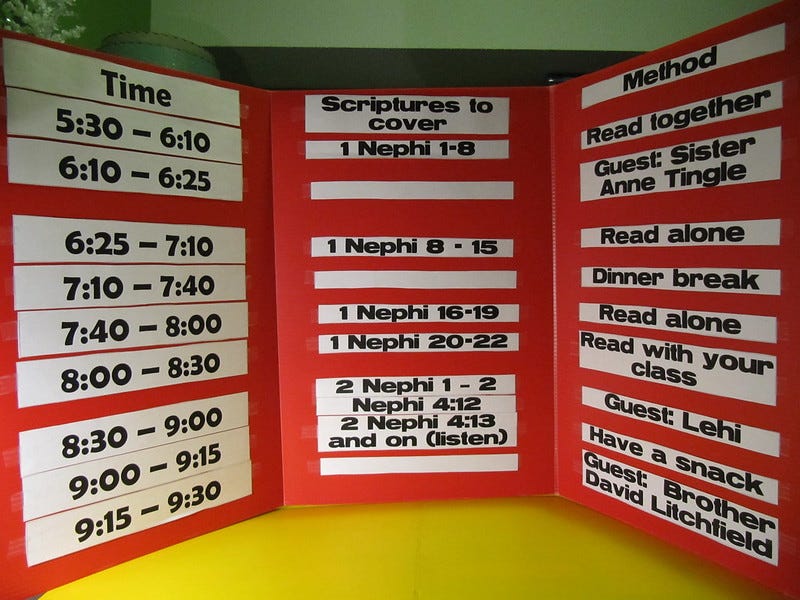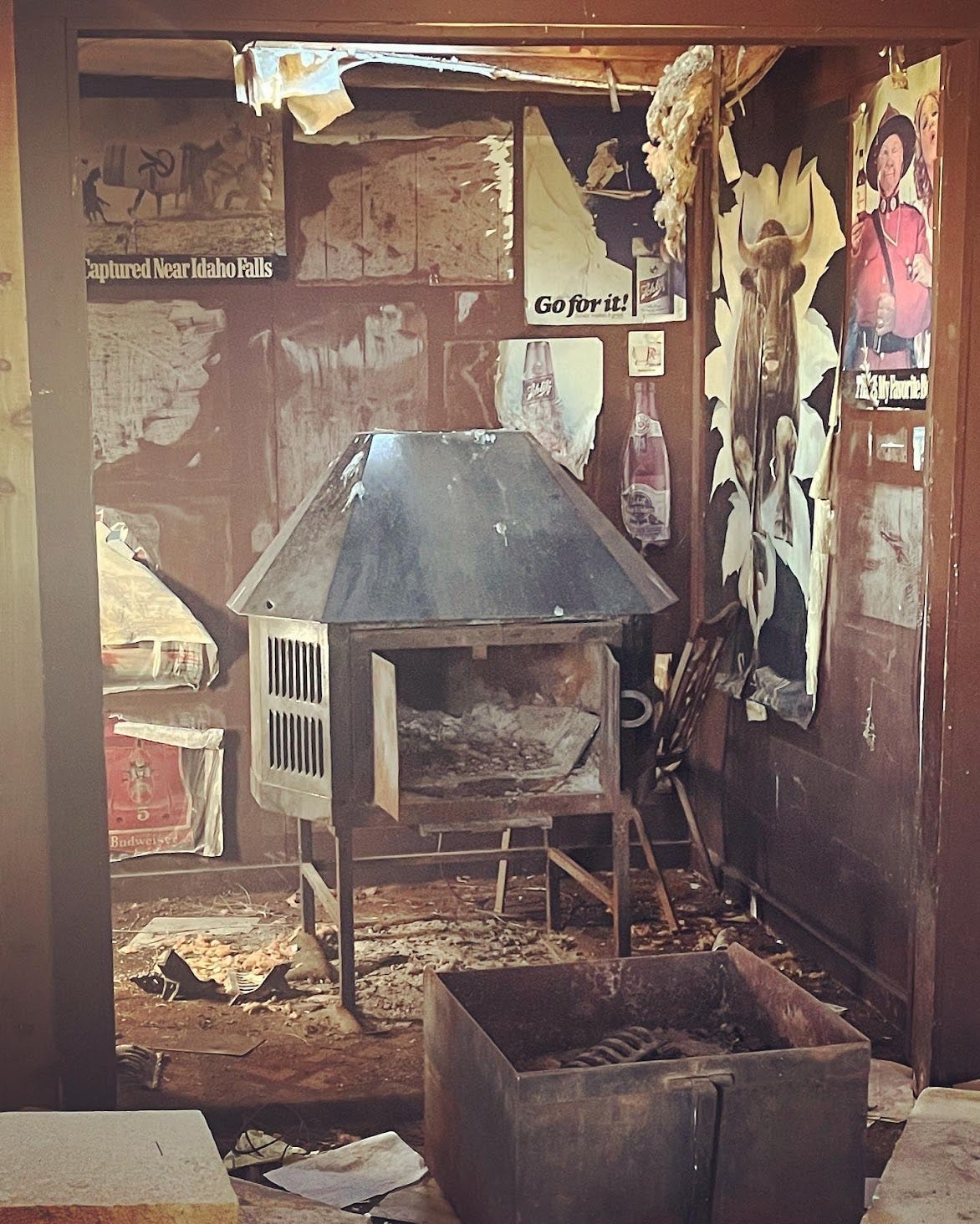A young woman of truth in Atomic City, Nevada
Finding the fragments of a life in the middle of nowhere

The Atomic City Bar is the only bar in Atomic City, Nevada. I think they should just call it “Bar.” Thomas wrote about our visit there last summer, with a mention of another bar, the one that lead us into Atomic City in the first place, standing empty and ravaged at a crossroads in the middle of the Nevada desert.
Having driven past the intersection of Highways 61 and 49 not so many days ago, I have a new respect for the power of crossroads. This visit definitely had its own weird magic to it.
The bar looked like it’d been closed for decades. After poking around online a bit, I was suprised to find this post by two cyclists who stopped in for a beer to get out of the rain… in 2010:
At long last we saw buildings in the distance, which were, in fact, near Atomic City. It was actually a bar…We parked our bicycles under the bar's veranda, and went into the bar to dry out (a strange thing to try to do in a bar).
On first look, this was your Classic Redneck Bar, with the You-will-get-beat-up-in-here, look. The first room had a dirt floor, and there were some pictures of almost naked women on the wall. Not just one or two, but at least 2 dozen. I wonder how many beer ads they had to cut up to get these. That is the visual. But on paying attention, the men in here were watching PBS Idaho, which especially in this area, would be pretty liberal. There was also a man with a gray beard telling a hunting story, not the “I blew the deer away” variety, but rather a down home story that a grandfather could tell kids in a church. So, stereotypes do end, in some places.
Speaking of how stereotypes end: it was also owned and operated by a Mormon family.
When we stopped off the side of the road to take a look inside the bar, we found the beer fridge still intact, the Budweiser girl pics still pinned to the wall. It’d clearly been visited by beer-drinkers of the free-range variety, who’d burned campfires on the inside of the building, shattered mirrors and spray-painted graffiti all over the walls.
Scattered amongst the debris were family photos, including a studio portrait who I assume were the elderly parents of the proprietor. There were also school pics of a young blonde girl with curled bangs, who I’m sure was the person who filled out the worksheets in a weather-beaten binder lying on the bar.
The pages were curled with moisture and spotted, but still legible; it was an LDS Young Women’s Improvement Association Personal Progress workbook/journal.
The author, who I’ll just call K., wrote about how she was glad that her Irish-American parents gave her a fashionable 20th century name, rather than a traditional Gaelic one. She wrote that she wanted to go on a mission and then attend Ricks College or Brigham Young University. Then she wanted to get married, have kids, and live in a country house in Utah. Her first two childhood friends were named Missy and Sissy. She inherited her father’s hair, eyes and teeth, and her mom’s feet.
The first page, titled “Young Woman of Truth Recognition,” notes that K. recieved her workbook in September of 1992. You can see a digial version of that workbook online, which is very similar to what was in K.’s binder: fill-in-the blank sheets broken up by category for Beehives, MIA Maids and Laurels.
Those groups, first established more than a century ago, were roughly equivalent to LDS Girl Scout Troops. I say “were” because in 2019, the LDS Church did away with that system so that they could mix up ages and be a bit more modern in their approach.
For the first half of the workbook — the “Beehives” section — K. diligently checked things off. She volunteered to babysit for free so parents could go to their local LDS temple. She picked out her favorite temple, and found a picture of it to hang in her room. She fasted on Sunday. She prayed. She worked with her mom to plan dinner for the family for a week. Her mom, J., and her young women’s leader, also J., dilgently signed off on signature lines as K. completed each task.
By the time she started working on the MIA Maids exercises, she’d clearly lost interest . She completed one very early exercise in MIA Maids:
Draw or obtain a picture showing the plan of salvation (our premortal existence, birth, mortal life, death, Christ’s judgment, and our life after death). Use the picture to explain eternal progression to your class, family or a friend.
And then she stopped. The workbook sheets for the Laurels section are blank. It’s not weird for teen girls to lose interest in churchy stuff and turn to terrestrial teen-girl things, like soccer or proms or dates or math competitions or college prep. It looks like maybe that’s what happened in K.’s case.

K. began working on her binder during a very interesting moment in the LDS Church — it was right around the time that a group of LDS feminists in Salt Lake City were excommunciated for insisting that Heavenly Mother was part of the Godhead. Two years later, in 1994, Janine Boyce wrote a critical essay about YWMIIA manuals in Dialogue: A Journal of Mormon Thought, noting that Young Women’s lesson manuals published in the ‘70s and early ‘80s differed very little from the 1992 version that K. used.
Boyce continued:
According to Lavina Fielding Anderson, manuals published in 1977 and 1978 succeeded in explaining doctrinal subjects, although they were ineffective in clearly defining priesthood responsibilities and in giving realistic examples of motherhood. She also noted that the lessons contained no examples of working women; she felt the manuals side-stepped the issue of divorce, of education for women, and of the possibilities of combining motherhood and professional life. Anderson stated that the lessons portrayed modesty as a problem for girls only, and she worried that the lessons were '"herding' the girls into 'femininity'" by placing too much emphasis on external physical traits.
In some respects, little has changed since Anderson wrote her article twelve years ago. Sadly, many of the problems Anderson described have not been rectified in the newer manuals. The current lessons have improved slightly, but they still do not discuss full-time missionary work for women, encourage education for women, cite realistic examples of motherhood, and support working women and non-traditional families. Perhaps not as much emphasis is placed on femininity in the new manuals, although they do include lessons on proper grooming.
The problem, she said, was that these manuals didn’t consider the fact that “the dynamics of Mormon families have changed over the years….Mormon couples are having fewer children (three to five instead of seven to ten), 48 percent more mothers are working outside the home, a greater number of couples are divorcing — especially young couples — and 30 percent of the population of the church is comprised of single adults.”
It definitely didn’t take into consideration that there might be an LDS family running an Irish bar at a crossroads in the middle of the Nevada desert. A family who hung immodest images of bikini girls on the paneled walls, and served cheap beers to atomic plant workers and grizzled oldsters who liked watching PBS Idaho.
What happened to K.? Is she one of the 25 current residents of Atomic City? Did she go to BYU, marry and have kids and raise them in a country house in Utah? Did she hear about Lavina Fielding Anderson and decide to enroll in the University of Utah instead? Did she move to Portland? Upstate New York? Is she a gradmother? A banker? A Reiki master?
We humans are so unformed at the age of 12, it’s hard to even speculate about where she landed, or who she became. Wherever and whoever she is, here’s to hoping this young woman of truth evovled into a middle-aged woman of truth, one who’s living her best life.









I came across your column by sheer accident a few weeks ago, and since then I have read everything you've dropped, but I wanna chime in finally and say how grateful I am for what you do. These kinds of things are the most interesting to me - these little insights into otherwise unseen histories - and I'm so happy someone is out there finding and sharing them. Your work is SO good!
This remarkable newsletter, as the subtitle indicates, finds “the fragments of a life in the middle of nowhere.” After introducing those fragments Stefene by real research finds more of those fragments and by her own analysis places everything for us in its own sociological setting. Well done!